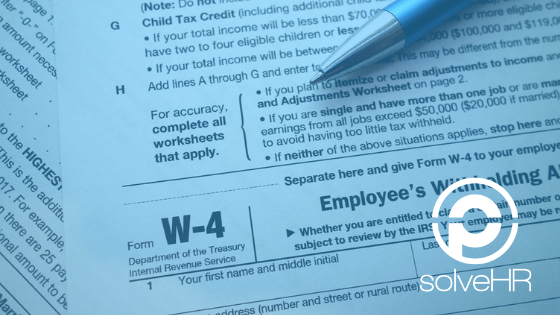In 2017 Congress passed the Tax Cuts and Jobs Act, one of the largest overhauls of the tax code in three decades. This prompted the IRS to simplify Form W-4, which instructs employers on how much tax to withhold from their employees, and in 2020 the form has gotten a makeover.

We discussed in a previous post the draft that the IRS posted in May, but new changes were finalized this month with major revisions. The updates to the form reflect the changes to the tax law in 2018 and the IRS is not requiring all employees to complete the revised form. However, any employees hired in 2020 or after, and anyone who makes withholding changes in the same timeframe will be required to fill out a new form.
For this post we’ll be going over the simple steps an employee needs to take to fill out the new Form W-4 and answer some common questions we get about the new changes.
Step by Step
So, what’s changed in the new W-4? Well the new 2020 Form W-4 has eliminated the page that had employees fill out their personal allowances and replaced it with a new five-step process to make it simpler to fill out. Bellow are the five steps that you need to follow when filling out the new W-4:
- Step 1 Personal Information
- Enter all personal information, including your name
- Social Security Number, home address
- Filing Status,
- Single or married filing separately
- Married filing jointly (for Qualifying widowers)
- Head of household (check only if you’re married, pay more than half the costs of keeping up a home for yourself and qualifying individual)
- Step 2 (optional) - Multiple Jobs or Spouse Works
- Use the estimator Tax withholding estimator from the IRS’s website for the most accurate withholding information
- Use the Multiple Jobs Worksheet on page 3 and enter the result in Step 4c) for roughly accurate withholding; or
- If there are only two jobs total, you may check this box. Do the same on Form W-4 for the other job.
- Step 3 (optional) – Claim Dependents
- Claiming dependents for each child multiply the number of children at $2,000 per-child child tax credit or $500 for other dependents out of your withholding.
- Step 4 (optional) – Other Adjustments
- Other income (not from jobs). If you want tax withheld for other income you expect this year that won’t have withholding, enter the amount of other income here. This may include interest, dividends, and retirement income
- Deductions. If you expect to claim deductions other than the standard deduction and want to reduce your withholding, use the deductions worksheet on page 3 and enter the results
- Extra withholding. Enter any additional tax you want withheld each pay period
- Step 5 – Sign the Document
If you noticed something about the new layout, it was probably that three of the five steps are now optional to fill out. Employees are must complete steps 1 and 5, but steps 2, 3, and 4 ensure that the employees federal income tax withholding accurately matches their tax liability.
Common Questions
“Does everyone have to complete a new Form W-4?”
No. You are required to complete the new form if you’re hired by a new employer in 2020 or if you have more (or less) money withheld from your paycheck. The ladder usually occurring due to changes in an employee’s financial situations like having a child, getting married, or losing or gaining household income.
“Should I file a new W-4 in 2020 even if I don’t have to?”
You do not have too, but the IRS encourages employees to review their withholdings each year and file a new W-4, if needed, to ensure enough money is being set aside for taxes.
The IRS has a helpful FAQ sections on their website that goes over more common questions for the form change. If you have any questions about withholdings, we implore you to seek assistance from a tax professional.
Are you struggling with managing your human resource needs? SolveHR offers several transactional and strategic HR services to help your business. Contact us today to find the right solution for you, so you can focus on what matters—growing your business!

